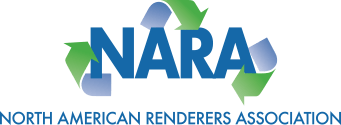Guest Post By NARA Staff Member, Heather Davis
During a recent personal vacation NARA’s Coordinator of Member Relations, Heather Davis, took a detour to visit two nearby NARA member rendering plants; G.A. Wintzer & Son Co, and The Dupps Company headquarters and equipment manufacturing hub. Heather was later joined by NARA’s Senior Vice President of Scientific Services, Dr. David Meeker.
We asked Heather to share her experience at both plant tours in a guest blog post, below.
A rendering plant isn’t a normal vacation destination, but I couldn’t resist the opportunity to tour the G.A. Wintzer & Son Co. rendering plant and The Dupps Company headquarters and equipment manufacturing hub since I was nearby. From my first plant tour at Mountaire with Brian Schoeberl, to my recent visit to G.A. Wintzer & Son Co., every plant visit has deepened my respect for an industry that is often misunderstood, underestimated, or entirely forgotten.
Sean Wintzer, 6th generation of Wintzers leading G.A. Wintzer & Son Company, welcomed me to their office in downtown Wapakoneta. The beautiful brick building includes the original family home built in the 1800s. A portrait of Sean’s great-great-great grandfather Charles, fingertips darkened with tannins from processing hides, hangs next to a display of leather goods made when the business focused on tanning. The rendering plant is a short drive away, narrowly compressed between a county highway and a railroad, though it’s expanding. Bill Butler, employed long enough to count his time in vague decades rather than years, supervised a new conveyer system loading poultry meal into a truck in one of the new buildings. At the rendering plant, a new boiler was being installed, a project multiple years in the making as the family re-organized to fit more equipment into limited space. In addition to their rendering facilities, they added a full water treatment plant in the 1960s to relieve the municipality of the task of handling rendering wastewater.
The Wintzers operate their own trucking fleet, mostly for raw material collection. In the 1980s, during the recession that cost many their livelihoods, the plant slowed production. Instead of leaving people unemployed, Gus Wintzer turned the plant’s third shift into truck mechanics. These days they have a dedicated Truck Maintenance shop with several qualified technicians on staff. A truck wash, originally built to reduce truck cab wear from salt on winter roads, helped the Wintzers respond to the HPAI outbreak in the poultry industry, and is still used to keep the trucks clean and sanitary today.
Sean credits much of their success to the expansion of animal agriculture in their area and good timing, but the family’s care for the community is clearly a factor. The tour was frequently punctuated by friendly chats and casual introductions with employees, some who are the 2nd or 3rd generation to work there. The company also donates to just about any good cause they get asked about. My time at Wintzer concluded with a walk through downtown Wapakoneta while Gus and Sean pointed out favorite local businesses.
NARA’s Dr. David Meeker met me for my second tour: The Dupps Company. Frank Dupps, President, greeted us warmly and Brett Sasser, Capital Equipment Sales, took us on a tour that felt like a personal episode of How It’s Made for a 440 Supercookor®. We saw incoming material (massive sheets of thick steel and pipes) get cut and shaped into parts, then assembled into completed rendering equipment. Much of the work is still done manually. Welding and assembly take a craftsman, and the huge plasma cutter (pride of its department) doesn’t program itself. Modern robotics refine some parts to prepare them for the next stage of the build, but instead of being replaced, workers are trained to operate and maintain the machines. The engineering, logistics, and skill to build and maintain specialty equipment was amazing to see in action.
Though much was learned at both plant visits about the facilities themselves, visiting members is about more than practical knowledge. Insight into company culture, challenges, and goals helps NARA better serve the industry. Every plant visit teaches compelling stories about the creative and thoughtful ways members contribute to animal agriculture and their communities.
NARA would like to thank Sean and Gus Wintzer, Frank Dupps, Brett Sasser, and all those who helped coordinate Heather and Dr. Meeker’s plant tours. Thank you for your continued support of NARA and the rendering industry.

